Variation in Dissolved Organic Matter Using Absorbance and Fluorescence Measurements during Dry Season in Sta. Rosa and Cabuyao Rivers, Philippines
Abstract
:1. Introduction
2. Materials and Methods
2.1. Study Area
2.2. Sampling Stations and Strategy
2.3. Physiochemical Analyses
2.4. Absorbance Measurements
Absorption Ratios
2.5. EEM Fluorescence Measurements
2.6. Statistical Analyses
3. Results
3.1. Physico-Chemical Properties of River Water
3.2. Absorption Ratios of SR and CR
3.3. Fluorescence Peaks in SR and CR
3.4. Fluorescence Indices of SR and CR
4. Discussion
5. Conclusions
Author Contributions
Funding
Institutional Review Board Statement
Informed Consent Statement
Acknowledgments
Conflicts of Interest
References
- Loucks, D.P.; van Beek, E. Water Resources Planning and Management: An Overview. In Water Resource Systems Planning and Management; Springer: Berlin/Heidelberg, Germany, 2017. [Google Scholar] [CrossRef] [Green Version]
- Khatri, N.; Tyagi, S. Influences of natural and anthropogenic factors on surface and groundwater quality in rural and urban areas. Front. Life Sci. 2015, 8, 23–39. [Google Scholar] [CrossRef]
- Sheldon, F.; Thomas, F.C.; Berry, O.; Puckridge, J. Using disaster to prevent catastrophe: Referencing the impacts of flow changes in large dryland rivers. Regul. Rivers Res. Manag. 2000, 16, 403–420. [Google Scholar] [CrossRef]
- Bertrand, C.; Siauve, V.; Fayolle, S.; Cazaubon, A. Effects of hydrological regime on the drift algae in a regulated Mediterranean river (River Verdon, southeastern France). Regul. Rivers Res. Manag. 2001, 17, 407–416. [Google Scholar] [CrossRef]
- DENR RA-9275, The Philippine Clean Water Act. 2015. Available online: https://emb.gov.ph/wp-content/uploads/2015/09/RA-9275.pdf (accessed on 10 November 2021).
- LLDA. Laguna Lake Development Authority Profile. Available online: https://llda.gov.ph/agency-profile/ (accessed on 11 October 2021).
- Cadondon, J.G.; Napal, J.P.D.; Abe, K.; de Lara, R.; Vallar, E.A.; Orbecido, A.H.; Belo, L.P.; Galvez, M.C.D. Characterization of water quality and fluorescence measurements of dissolved organic matter in Cabuyao river and its tributaries using excitation-emission matrix spectroscopy. J. Phys. Conf. Ser. 2020, 1593, 012033. [Google Scholar] [CrossRef]
- Barril, C.R.; Tumlos, E.T.; Moraga, W.C. Seasonal variations in water quality of Laguna de Bay, Philippines: Trends and implications. Philipp. Agric. Sci. 2001, 84, 19–20. [Google Scholar]
- De Jesus, A.L.M.; Baltazar, D.E.S.; Banalo, R.A.; Flavier, M.E. Water Quality Assessment of the Main River System flowing within Barangay Bucal, Calamba City, Laguna. In Proceedings of the 5th PNEE International Conference, Iloilo City, Philippines, 15–17 February 2012. [Google Scholar]
- Santos-Borja, A.; Nepomuceno, D.N. Laguna de Bay: Institutional development and charge for lake basin management. Lakes Reserv. Res. Manag. 2006, 11, 257–269. [Google Scholar] [CrossRef]
- DENR-DAO-06, Water Quality Guidelines and General Effluent Standards of 2016. Available online: https://denr.gov.ph/sectionpolicies/viewrec.php?id=4917&page=1&sort=tl&filter=&search (accessed on 4 June 2019).
- US EPA. Water Quality Criteria. Available online: https://www.epa.gov/wqc (accessed on 2 July 2021).
- Coble, P. Marine optical biogeochemistry: The chemistry of ocean color. Chem. Rev. 2007, 107, 402–418. [Google Scholar] [CrossRef]
- Guo, X.; Jiang, J.; Xi, B.; He, X.; Zhang, H.; Deng, Y. Study on the spectral and Cu (II) binding characteristics of DOM leached from soils and lake sediments in the Hetao region. Environ. Sci. Pollut. Res. 2012, 19, 2079–2087. [Google Scholar] [CrossRef]
- Fellman, J.; Hood, E.; Spenser, R. Fluorescence spectroscopy opens new windows into dissolved organic dynamics in freshwater ecosystems: A review. Limnol. Oceanogr. 2010, 55, 2452–2462. [Google Scholar] [CrossRef]
- Xu-jing, G.; Bel-dou, X.; Hui-bin, Y.; Wen-chao, M.; Xiao-song, H. The structure and origin of dissolved organic matter studied by UV-Vis spectroscopy and fluorescence spectroscopy in lake and semi-arid region. Water Sci. Technol. 2011, 63, 1004–1009. [Google Scholar] [CrossRef] [Green Version]
- Cory, R.; McKnight, D. Fluorescence spectroscopy reveals ubiquitous presence of oxidized and reduced quinones in dissolved organic matter. Environ. Sci. Technol. 2005, 39, 8142–81149. [Google Scholar] [CrossRef] [PubMed]
- Wilson, H.; Xenopoulos, M. Effects of agricultural land use on the composition of fluvial dissolved organic matter. Nat. Geosci. 2009, 2, 37–41. [Google Scholar] [CrossRef]
- Huguet, A.; Vacher, L.; Relexan, S.; Saubusse, S.; Froidefond, J.M.; Parlanti, E. Properties of fluorescent dissolved organic matter in the Gironde estuary. Org. Geochem. 2009, 40, 706–719. [Google Scholar] [CrossRef]
- Yao, X.; Zhang, Y.L.; Zhu, G.W.; Qin, B.Q.; Feng, L.Q.; Cai, L.L.; Gao, G. Resolving the variability of CDOM fluorescence to differentiate the sources and fate of DOM in Lake Tahu and its tributaries. Chemosphere 2011, 82, 145–155. [Google Scholar] [CrossRef]
- Zhang, Q.; Sun, P.; Chen, X.; Jiang, T. Hydrological extremes in the Poyang Lake basin, China: Changing properties, causes, and impacts. Hydrol. Process. 2011, 25, 3121–3130. [Google Scholar] [CrossRef]
- Brezonik, P.L.; Olmanson, L.G.; Finlay, J.C.; Bauer, M.E. Factors affecting measurement of CDOM by remote sensing of optically complex inland waters. Remote Sens. Environ. 2015, 157, 199–215. [Google Scholar] [CrossRef]
- Harvey, E.T.; Kratzer, S.; Anderson, A. Relationships between colored dissolved organic matter and dissolved organic carbon in different coastal gradients of the Baltic Sea. AMBIO 2015, 44 (Suppl. 3), 392–401. [Google Scholar] [CrossRef] [Green Version]
- Erlandsson, M.; Futter, M.N.; Kothawala, D.N.; Kohler, S.J. Variability in spectral absorbance metrics across boreal lake waters. J. Environ. Monit. 2012, 14, 2643–2652. [Google Scholar] [CrossRef]
- Kim, C.; Eom, J.; Jung, S.; Ji, T. Detection of organic compounds in water by an optical absorbance method. Sensors 2016, 16, 61. [Google Scholar] [CrossRef] [Green Version]
- Shen, Y.; Benner, R.; Robbins, L.L.; Wyan, J.G. Sources, distributions, and dynamics of dissolved organic matter in the Canada and Makarov Basins. Front. Mar. Sci. 2016, 3, 198. [Google Scholar] [CrossRef] [Green Version]
- Guo, M.X.; Chorover, J. Transport and fractionation of dissolved organic matter in soil columns. Soil Sci. 2003, 168, 108–118. [Google Scholar] [CrossRef]
- Santos, L.; Pinto, A.; Filipe, O.; Cunha, A.; Santos, E.B.H.; Almeida, A. Insights on the optical properties of estuarine DOM? Hydrological and biological influences. PLoS ONE 2016, 11, e0154519. [Google Scholar] [CrossRef] [PubMed] [Green Version]
- Duarte, R.M.B.O.; Pio, C.A.; Duarte, A.C. Spectroscopic study of the water-soluble organic matter isolated from atmospheric aerosols collected under different atmospheric conditions. Anal. Chim. Acta 2005, 530, 7–14. [Google Scholar] [CrossRef]
- Hunt, J.F.; Ohno, T. Characterization of fresh and decomposed dissolved organic matter using excitation-emission matrix fluorescence spectroscopy and multiway analysis. J. Agric. Food Chem. 2007, 55, 2121–2128. [Google Scholar] [CrossRef] [PubMed]
- Claret, F.; Schafer, T.; Bauer, A. Generation of humic and fulvic acid from Callovo-Oxfordian clay under high alkaline conditions. Sci. Total Environ. 2003, 317, 189–200. [Google Scholar] [CrossRef]
- Al-Juboori, R.A.; Yusaf, T.; Pittaway, P.A. Exploring the correlation between common UV measurements and chemical fractionation for natural waters. Desalination Water Treat. 2016, 57, 16324–16335. [Google Scholar] [CrossRef]
- Korshin, G.V.; Li, C.-W.; Bejamin, M.M. Monitoring the properties of natural organic matter through UV spectroscopy: A consistent theory. Water Res. 1997, 31, 1787–1795. [Google Scholar] [CrossRef]
- Jaffe, R.; Boyer, J.N.; Lu, X.; Maie, N.; Yang, C.; Scully, N.M.; Mock, S. Source characterization of dissolved organic matter in a subtropical mangrove-dominated estuary by fluorescence analysis. Mar. Chem. 2004, 84, 195–210. [Google Scholar] [CrossRef]
- Cieslewicz, J.; Gonet, S.S. Properties of humic acids as biomarkers of lake catchment management. Aquat. Sci. 2004, 66, 178–184. [Google Scholar] [CrossRef]
- Zhang, L.; Sun, Q.; Peng, Y.; Zhao, H.; Liu, H.; You, Y.; Zhang, Y. Components and structural characteristics of dissolved organic matter in the overlying water of the Beiyun River. Energy 2021, 221, 119921. [Google Scholar] [CrossRef]
- Chen, W.; Westerhoff, P.; Leenheer, J.A.; Booksh, K. Fluorescence excitation-emission matrix regional integration to quantify spectra for dissolved organic matter. Environ. Sci. Technol. 2003, 37, 5701–5710. [Google Scholar] [CrossRef] [PubMed]
- Yu, H.; Song, Y.; Gao, H.; Liu, L.; Yao, L.; Peng, J. Applying fluorescence spectroscopy and multivariable analysis to characterize structural composition of dissolved organic matter and its correlation with water quality in urban river. Environ. Earth Sci. 2015, 73, 5163–5171. [Google Scholar] [CrossRef]
- Williams, C.J.; Frost, P.C.; Morales-Williams, A.; Larson, J.H.; Richarson, W.; Chiandet, A.S.; Xenopoulos, M.A. Human activities cause distinct dissolved organic matter composition across freshwater ecosystems. Glob. Change Biol. 2015, 22, 613–626. [Google Scholar] [CrossRef] [PubMed]
- Mostofa, K.M.; Yoshioka, T.; Konohira, E.; Tanoue, E. Dynamics and characteristics of fluorescent dissolved organic matter in the groundwater, river, and lake water. Water Air Soil Pollut. 2007, 184, 157–176. [Google Scholar] [CrossRef]
- Herzsprung, P.; von Tumpling, W.; Hertkorn, N.; Harir, M.; Butner, O.; Bravidor, J.; Friese, K.; Schimtt-Kopplin, P. Variations of Dom quality in inflows of a drinking water reservoir: Linking of van Krevelen diagrams with EEMF spectra by rank correlation. Environ. Sci. Technol. 2012, 46, 5511–5518. [Google Scholar] [CrossRef]
- PSGC Interactive. “Province: Laguna (Province)”. Quezon City, Philippines: Philippine Statistics Authority. Available online: http://rsso04a.psa.gov.ph/laguna (accessed on 20 July 2021).
- DOH Census Population. Population Projections by Region, Province, City/Municipality and Baranngay from 2020–2025. 2015. Available online: https://doh.gov.ph/sites/default/files/publications/Population%20Projections%20by%20Region%2C%20Province%2C%20Cities%20and%20Municipalities%2C%202020-2025.pdf (accessed on 5 August 2021).
- Hydrology and Water Quality. 2012. Available online: https://www.srcity.org/DocumentCenter/View/4050/Draft-Environmental-Impact-Report-North-Santa-Rosa-Station-Area---DEIR-Chapter38-PDF?bidId= (accessed on 3 July 2021).
- PAGASA. Climate of the Philippines. Available online: https://www.pagasa.dost.gov.ph/information/climate-philippines (accessed on 17 April 2022).
- “CLIMATE: LAGUNA”. Available online: https://en.climate-data.org/asia/philippines/laguna-1844/ (accessed on 5 July 2021).
- “JICA Report”. Available online: https://openjicareport.jica.go.jp/pdf/11948882_02.pdf (accessed on 4 April 2022).
- Hu, C.; Muller-Karger, F.E.; Zepp, R.G. Absorbance, absorption coefficient, and apparent quantum yield: A comment on common ambiguity in the use of these optical concepts. Limnol. Oceanogr. 2002, 47, 1261–1267. [Google Scholar] [CrossRef]
- Li, P.; Hur, J. Utilization of UV-Vis spectroscopy and related data analyses for dissolved organic matter (DOM) studies: A review. Crit. Rev. Sci. Technol. 2017, 479, 131–154. [Google Scholar] [CrossRef]
- Jin, M.Y.; Oh, H.-J.; Shin, K.-H.; Jang, M.-H.; Kim, H.-W.; Choi, B.; Lin, Z.-Y.; Heo, J.S.; Oh, J.-M.; Chang, K.-H. The Response of Dissolved Organic Matter during Monsoon and Post-Monsoon Periods in the Regulated River for Sustainable Water Supply. Sustainability 2020, 53, 5310. [Google Scholar] [CrossRef]
- Altmann, J.; Massa, L.; Sperlich, A.; Gnirss, R.; Jekel, M. UV254 absorbance as real-time monitoring and control parameter for micropollutant removal in advanced wastewater treatment with powdered activated carbon. Water Res. 2016, 94, 240–245. [Google Scholar] [CrossRef]
- Ziska, A.D.; Park, M.; Anumol, T.; Snyder, S.A. Predicting trace organic compound attenuation with spectroscopic parameters in powdered activated carbon processes. Chemosphere 2016, 156, 163–171. [Google Scholar] [CrossRef]
- Stedmon, C.A.; Markager, S.; Kaas, H. Optical properties and signatures of chromophoric dissolved organic matter (CDOM) in Danish coastal waters. Estuar. Coast. Shelf Sci. 2000, 51, 267–278. [Google Scholar] [CrossRef]
- Peacock, M.; Burden, A.; Cooper, M.; Dunn, C.; Evans, C.D.; Fenner, N.; Freeman, C.; Gough, R.; Hughes, D.; Huges, S.; et al. Quantifying dissolved organic carbon concentrations in upland catchments using phenolic proxy measurements. J. Hydrol. 2013, 477, 251–260. [Google Scholar] [CrossRef] [Green Version]
- Osburn, C.L.; Boyd, T.J.; Montgomery, M.T.; Coffin, R.B.; Bianchi, T.S.; Paerl, H.W. Optical proxies for terrestrial dissolved organic matter in estuaries and coastal waters. Front. Mar. Sci. 2016, 36910, 2571–2581. [Google Scholar] [CrossRef] [Green Version]
- Giancoli Barreto, S.R.; Nozaki, J.; Barreto, W.J. Origin of dissolved organic carbon studies by UV-Vis spectroscopy. Acta Hydrochim. Hydrobiol. 2003, 31, 513–518. [Google Scholar] [CrossRef]
- Yamashita, Y.; Maie, N.; Briceno, H.; Jaffe, R. Optical characterization of dissolved organic matter in tropical rivers of the Guayana Shield, Venezuela. J. Geophys. Res. Biogeosci. 2010, 115. [Google Scholar] [CrossRef] [Green Version]
- Baker, A.; Spencer, R.G.M. characterization of dissolved organic matter from source to sea using fluorescence and absorbance spectroscopy. Sci. Total Environ. 2004, 333, 217–232. [Google Scholar] [CrossRef]
- Cadondon, J.G.; Vallar, E.A.; Belo, L.P.; Orbecido, A.H.; Galvez, M.C.D. UV-Vis absorbance and fluorescence characterization of Pasig River surface water samples towards the development of an LED fluorescence lidar system. IJASEIT 2021, 11, 968–980. [Google Scholar] [CrossRef]
- Matsuoka, A.; Bricaud, A.; Benner, R.; Para, J.; Sempere, R.; Prieur, L.; Belanger, S.; Babin, M. Tracing the transport of colored dissolved organic matter in water masses of the Southern Beaufort Sea: Relationship with hydrographic characteristics. Biogeosciences 2012, 9, 925–940. [Google Scholar] [CrossRef] [Green Version]
- Rodriguez, F.J.; Schlenger, P.; Garcia-Valverde, M. Monitoring changes in the structure and properties of humic substances following ozonation using UV-Vis, FTIR and 1H-NMR techniques. Sci. Total Environ. 2016, 541, 623–637. [Google Scholar] [CrossRef]
- Ikeya, K.; Watanabe, A. Direct expression of an index for the degree of humification of humic acids using organic carbon concentration. Soil Sci. Plant Nutr. 2003, 49, 47–53. [Google Scholar] [CrossRef]
- Yakimenko, O.; Khundzhua, D.; Izosimov, A.; Yuzhakov, V.; Patsaeva, S. Sources indicator of commercial humic products: UV-Vis and fluorescence proxies. J. Soils Sediments 2016, 18, 1279–1291. [Google Scholar] [CrossRef]
- Hur, J.; Williams, M.A.; Schlautman, M.A. Evaluating spectroscopic and chromatographic techniques to resolve dissolved organic matter via end member mixing analysis. Chemosphere 2006, 63, 387–402. [Google Scholar] [CrossRef] [PubMed]
- Goldman, J.H.; Rounds, S.A.; Needoba, J.A. Applications of Fluorescence Spectroscopy for Predicting Percent Wastewater in an Urban Stream. Environ. Sci. Technol. 2012, 46, 4374–4381. [Google Scholar] [CrossRef]
- Chen, M.F.; Wu, J.; Lv, Y.L.; Chen, Q.J. Fluorescence properties of municipal wastewater. Acta Opt. Sin. 2008, 28, 578–582. [Google Scholar] [CrossRef]
- Yin, H.; Wang, Y.; Yang, Y.; Huang, J.; Xu, Z. Tryptophan-like fluorescence as a fingerprint of dry-weather misconnections into storm drainage system. Environ. Sci. Eur. 2020, 32, 61. [Google Scholar] [CrossRef] [Green Version]
- Cory, R.M.; Miller, M.P.; McKnight, D.M.; Guerard, J.J.; Miller, P.L. Effect of instrument-specific response on the analysis of fulvic acid fluorescence spectra. Limnol. Oceanogr. Methods 2010, 8, 67–78. [Google Scholar]
- Ohno, T.; Fernandez, I.J.; Hiradate, S.; Sherman, J.F. Effects of soil acidification and forest type on water soluble soil organic matter properties. Geoderma 2007, 140, 176–187. [Google Scholar] [CrossRef]
- Regis, E. The Pasig River: Caring for a Dying Ecosystem; The Pasig River Rehabilitation Commission: Quezon City, Philippines, 2001. [Google Scholar]
- Parlanti, E.; Worz, K.; Geoffroy, L.; Lamotte, M. Dissolved organic matter fluorescence spectroscopy as a tool to estimate biological activity in a coastal zone submitted to anthropogenic inputs. Org. Geochem. 2000, 31, 1765–1781. [Google Scholar] [CrossRef]
- Baker, A.; Bolton, L.; Newson, M.; Spencer, R.G.M. Spectrophotometric properties of surface water dissolved organic matter in an afforested upland peat catchment. Hydrol. Process. 2008, 22, 2325–2336. [Google Scholar] [CrossRef]
- LLDA Water Quality Monitoring Report 2019–2020. Available online: https://llda.gov.ph/annual-report/ (accessed on 1 July 2021).
- Zhang, Y.; Liu, M.; Qin, B.; Feng, S. Phytochemical degradation of chromophoric-dissolved organic matter exposed to simulated UV-B and natural solar radiation. Hydrobiologia 2009, 627, 159–168. [Google Scholar] [CrossRef]
- Jiang, T.; Skyllberg, U.; Bjorn, E.; Green, N.W.; Tang, J.; Wang, D.; Gao, J.; Li, C. Characteristics of dissolved organic matter (DOM) and relationship with dissolved mercury in Xiaoqing River-Laizhou Bay estuary, Bohai Sea, China. Environ. Pollut. 2017, 223, 19–30. [Google Scholar] [CrossRef] [PubMed] [Green Version]
- Catalan, N.; Obrador, B.; Felip, M.; Pretua, J.L. Higher reactivity of allochthonous vs autochthonous DOC sources in a shallow lake. Aquat. Sci. 2013, 75, 581–593. [Google Scholar] [CrossRef]
- Park, S.M.; Shin, Y.K. The impact of monsoon rainfall on the water quality in the upstream watershed of southern Han River. Korean J. Ecol. Environ. 2011, 44, 373–384. [Google Scholar]
- Bianchi, T.S. The role of terrestrially derived organic carbon in the coastal ocean: A changing paradigm and the priming effect. Proc. Natl. Acad. Sci. USA 2013, 108, 19473–19481. [Google Scholar] [CrossRef] [Green Version]
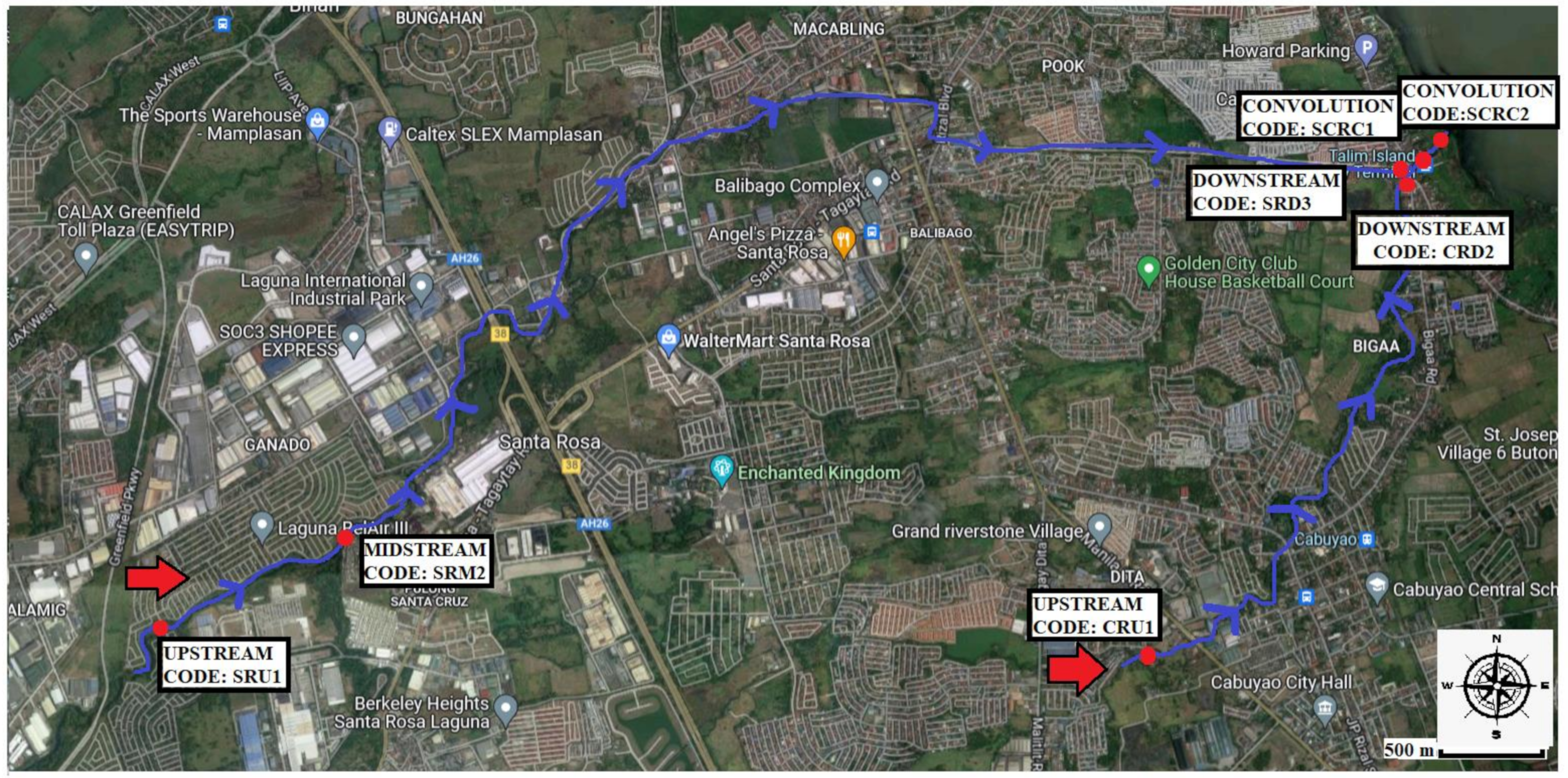
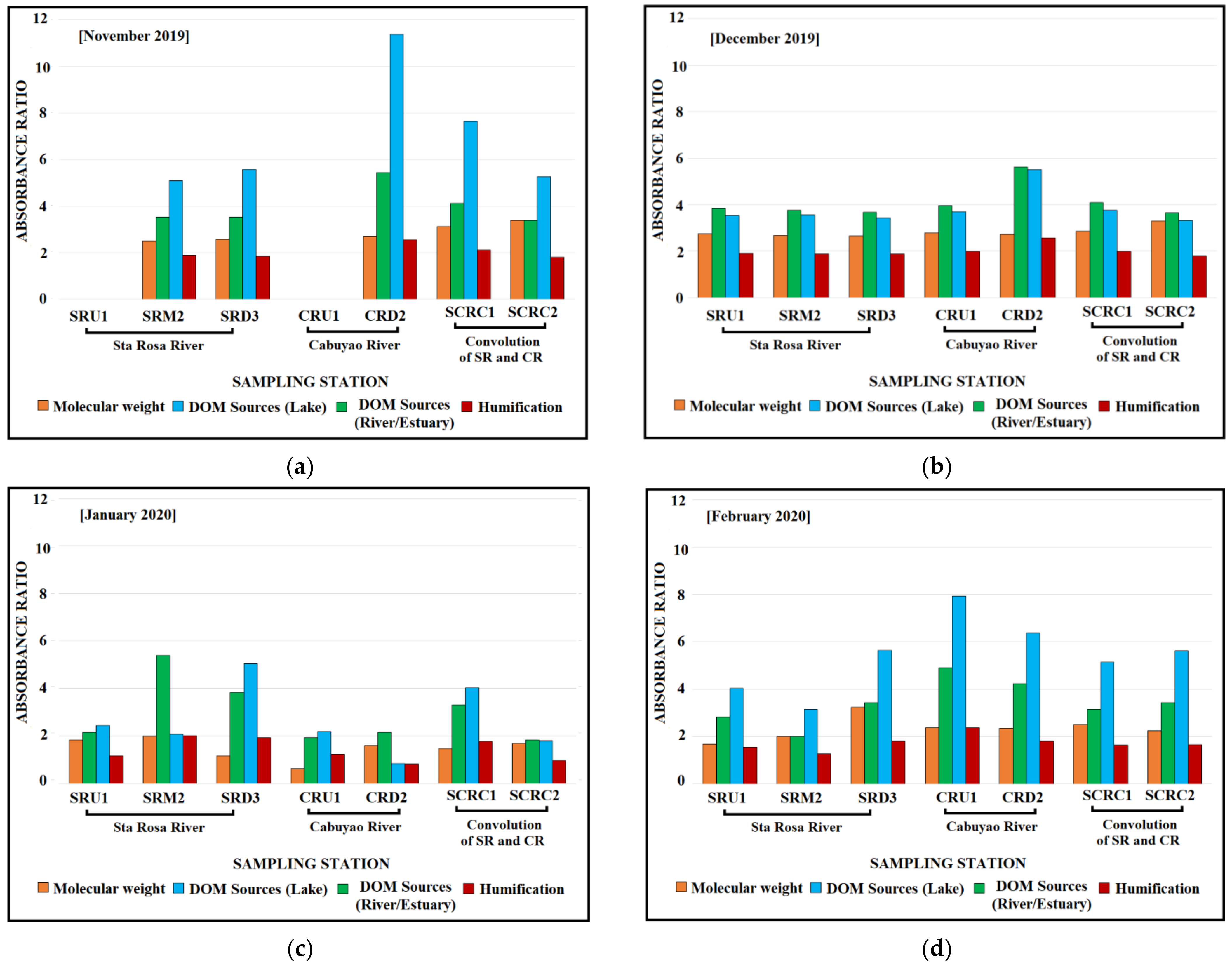
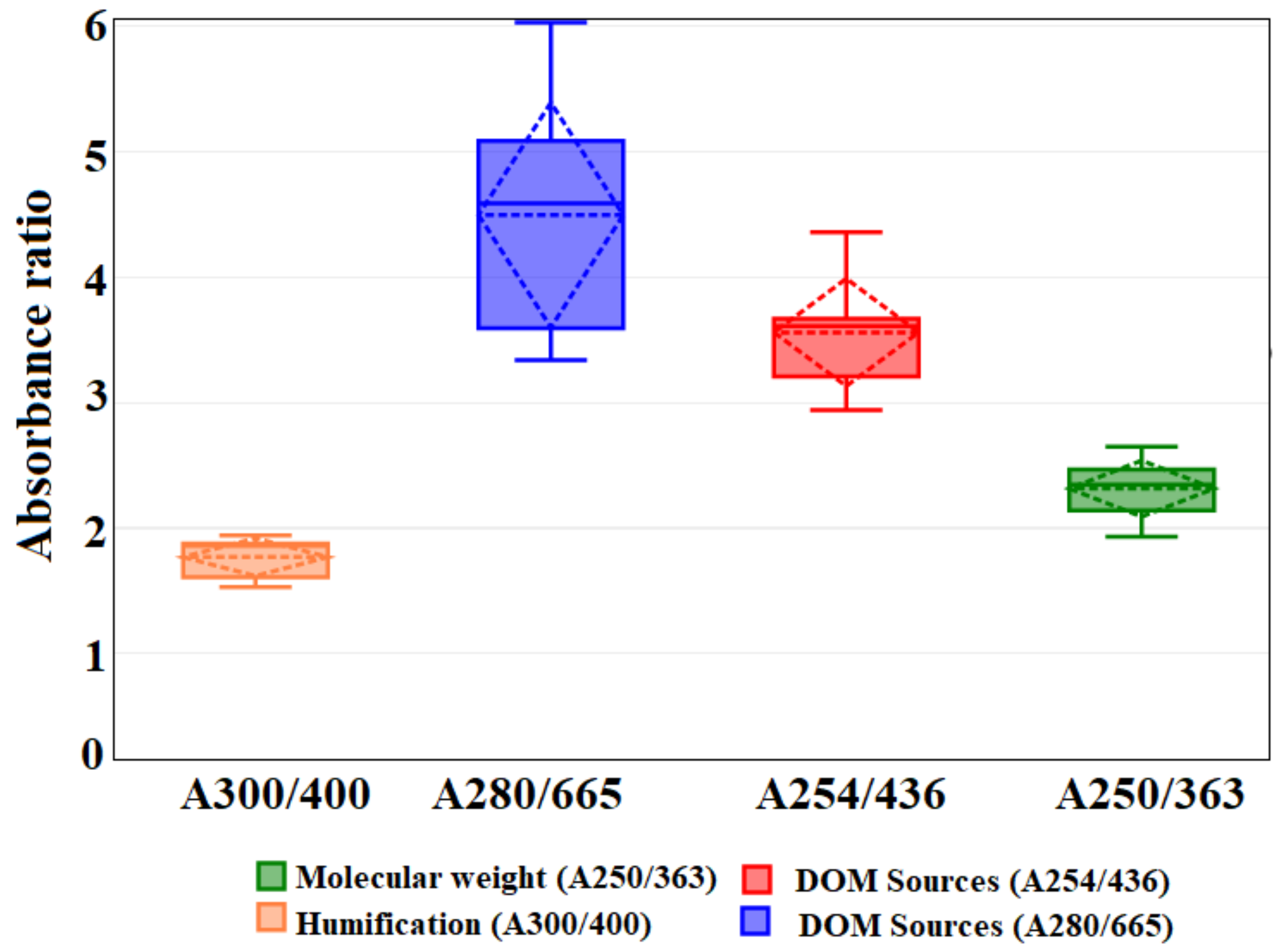
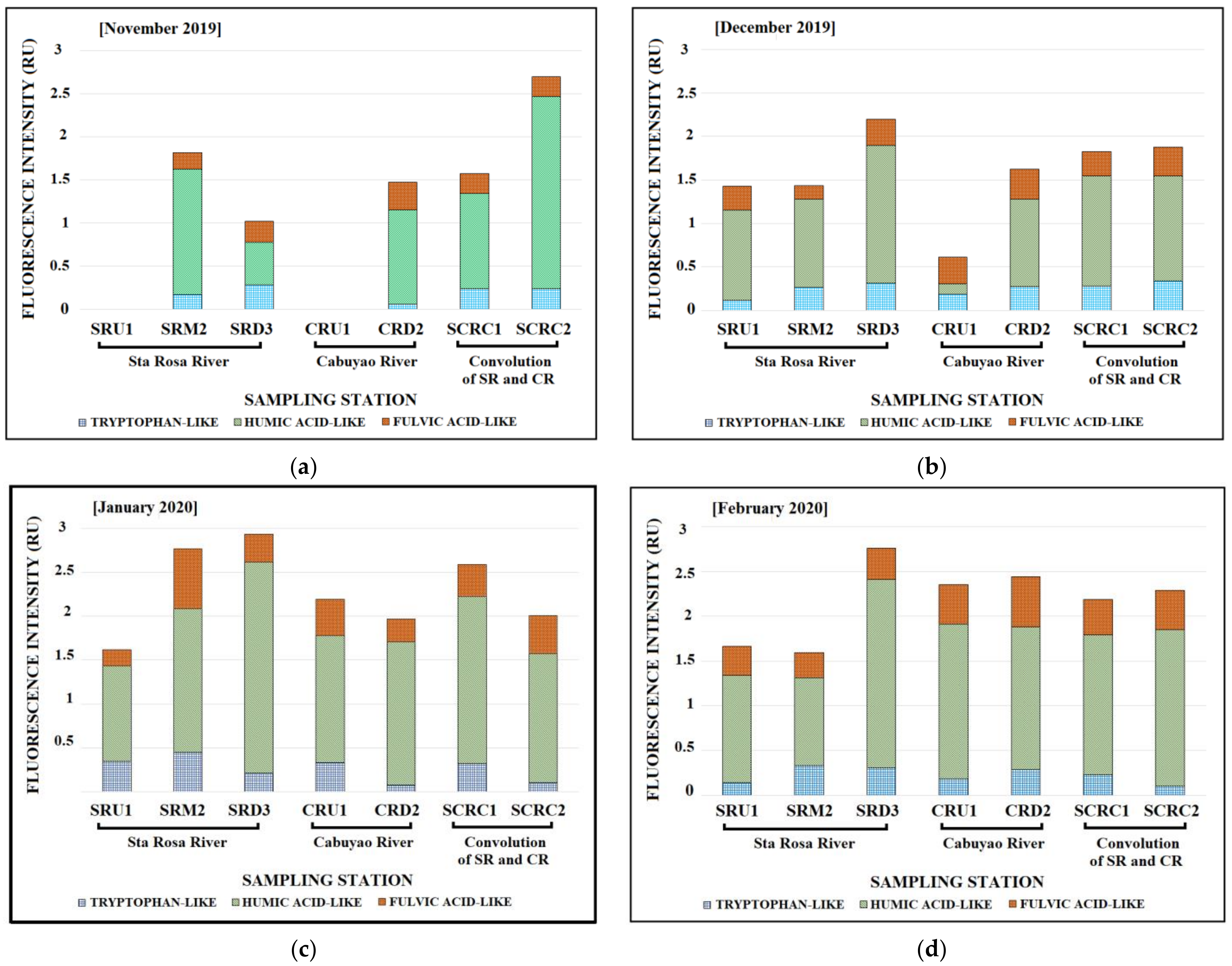
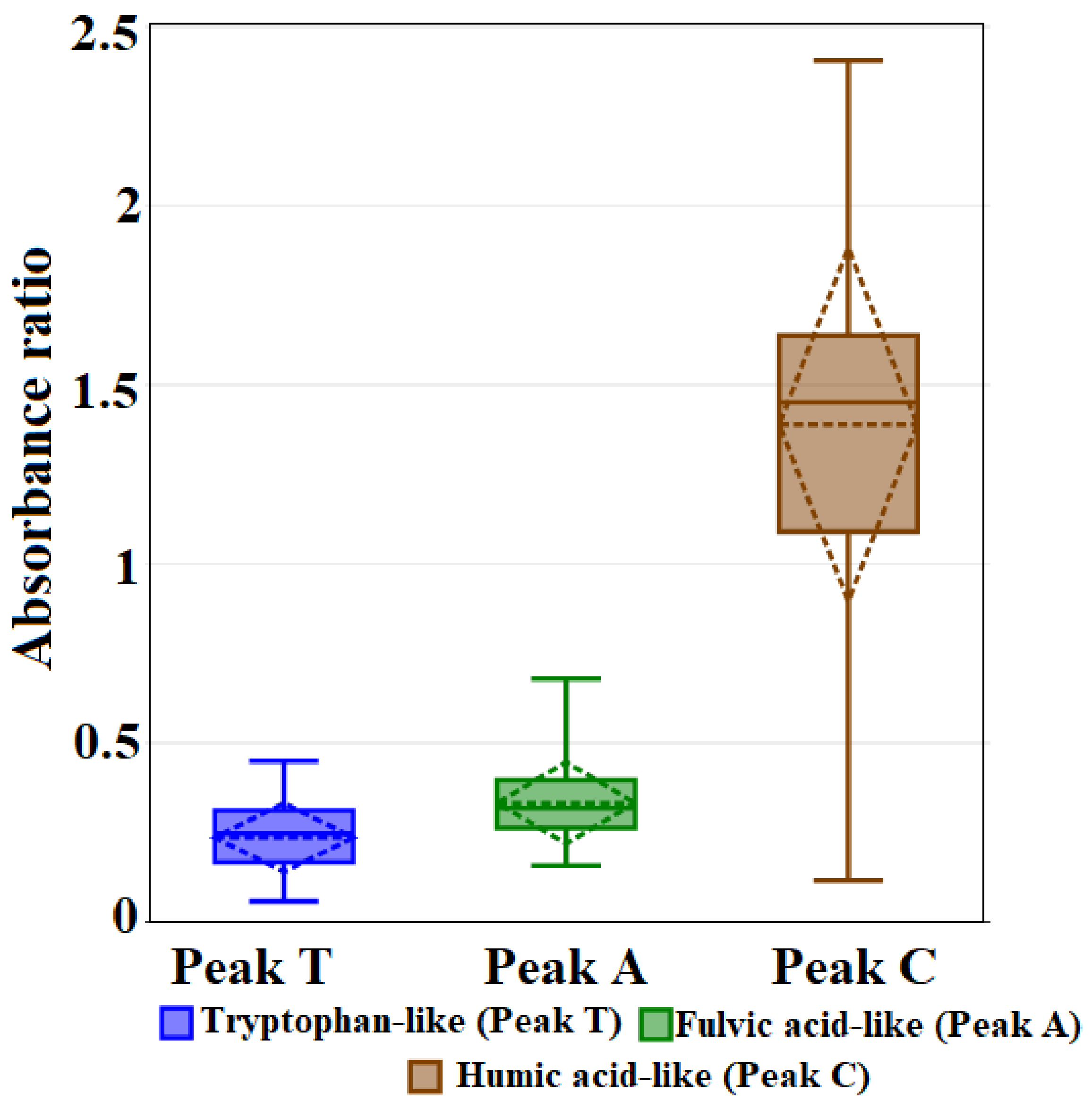
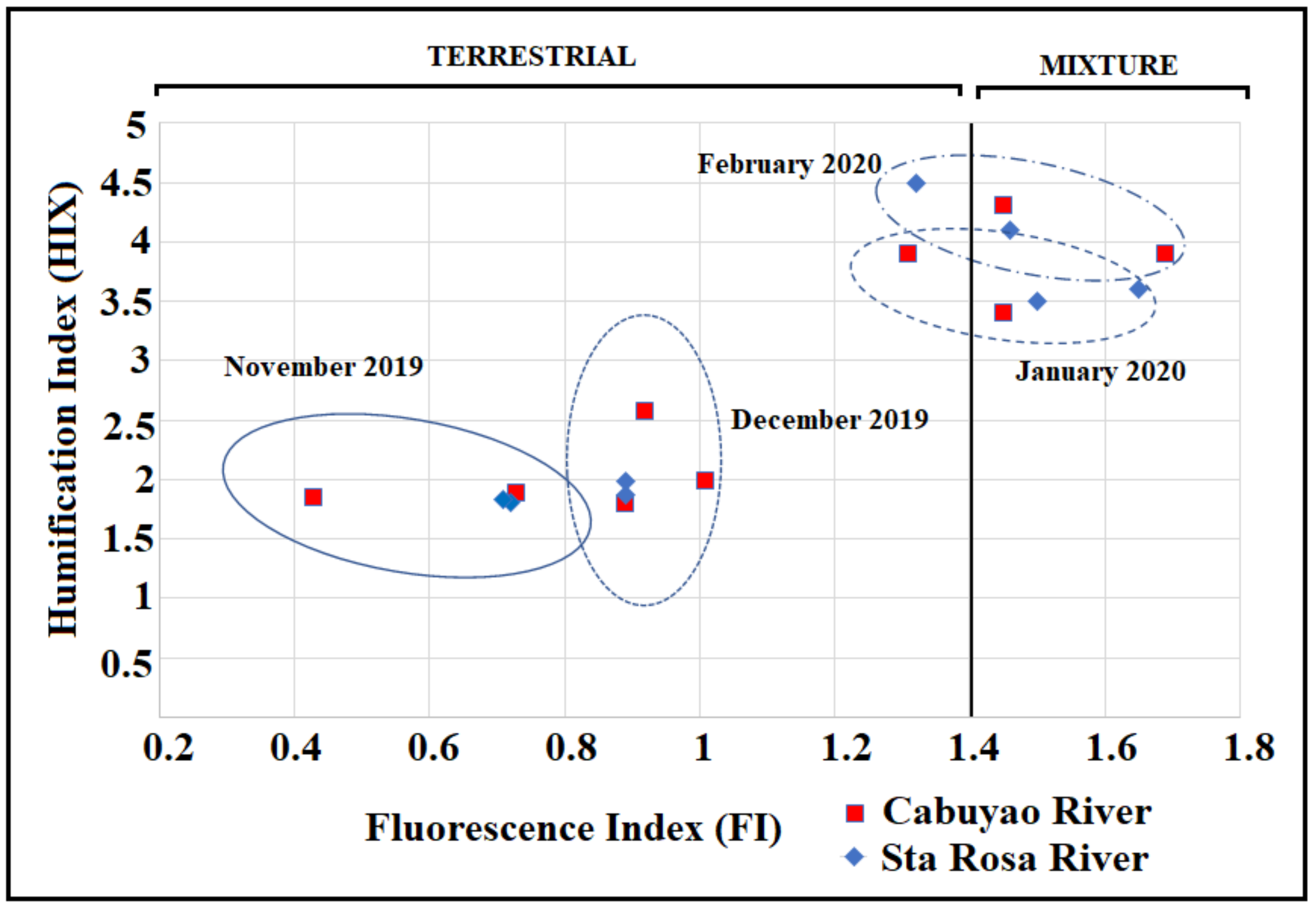
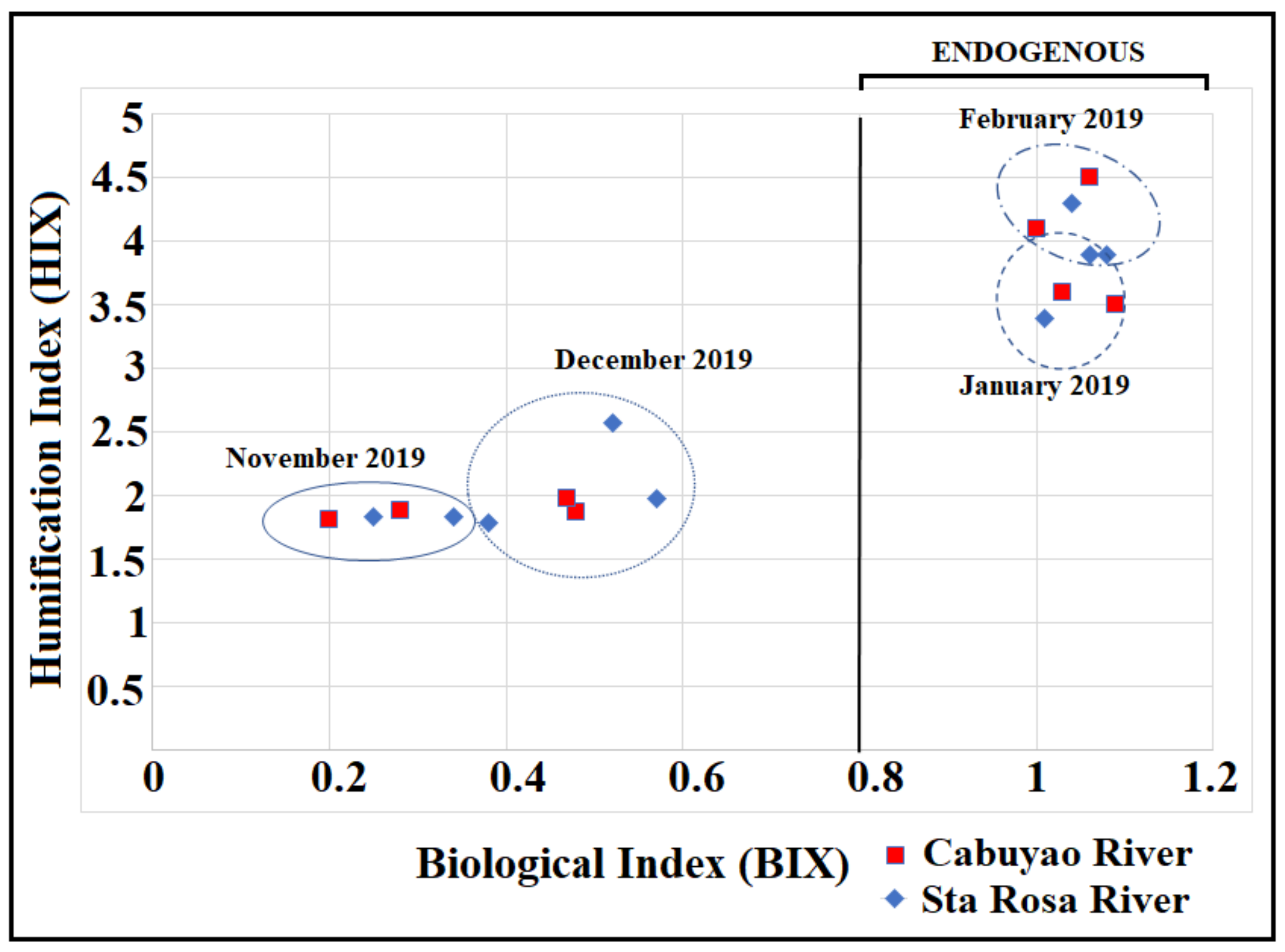
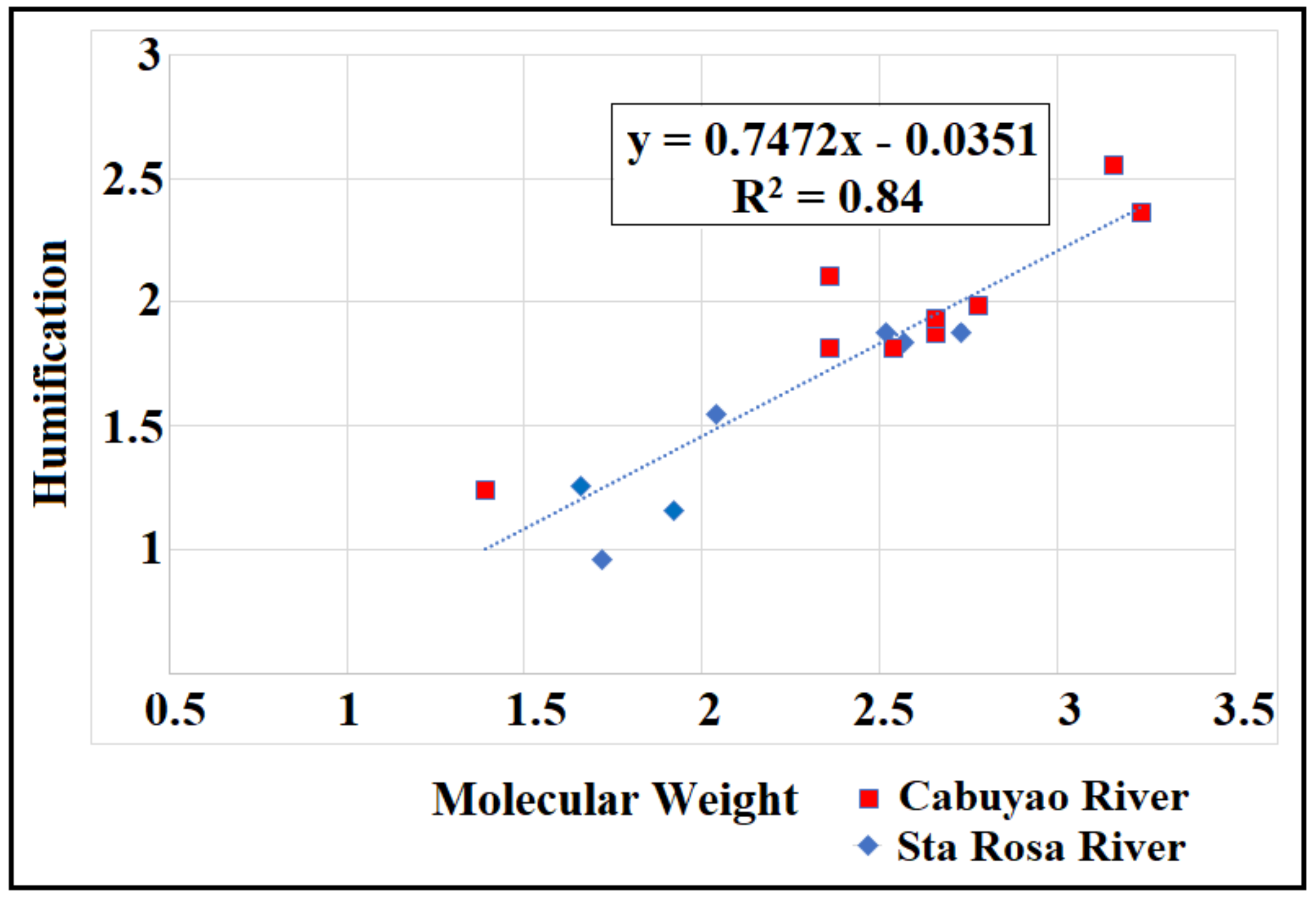
| River | Watershed Area (km2) | Approximate Length (km) | Land Use (%) | ||||
|---|---|---|---|---|---|---|---|
| Commercial-Residential | Grass Lands | Industrial | Mixed Crop | Rice Lands | |||
| SR | 115 | 27 | 0.12 | 0.11 | 0.04 | 0.05 | 0.07 |
| CR | 19.5 | 0.08 | 0.06 | 0.02 | 0.02 | 0.08 | |
| Station | Description | Coordinates | Land Use Type |
|---|---|---|---|
| SRU1 | Upstream flow of Sta. Rosa River | 14°15′12.6023″ E 121°03′14.8066″ N | Grassland, commercial or industrial, Low residential |
| SRM2 | Midstream flow of Sta Rosa River | 14°16′34.3380″ E 121°4′16.9716″ N | Low residential |
| SRD3 | Downstream flow of Sta Rosa River | 14°17′46.9860″ E 121°7′40.2996″ N | High residential, commercial or industrial |
| CRU1 | Upstream flow of Cabuyao River | 14°16′32.1385″ E 121°7′5.5740″ N | High residential, commercial, or industrial |
| CRD2 | Downstream flow of Cabuyao River | 14°17′46.1256″ E 121°7′40.0736″ N | Cropland, Low residential |
| SCRC1 | Convolution of SR and CR | 14°17′47.2644″ E 121°7′41.8080″ N | High residential, fishing |
| SCRC2 | Connected to Laguna Lake | 14°17′52.7532″ E 121°7′48.3724″ N | High residential, fishing |
| Sampling Month | Weather Conditions | Observations | ||
|---|---|---|---|---|
| Air Temp. (°C) | Mean Precipitation (mm) | Humidity (%) | ||
| November 2019 | 26 | 0.08 | 72 | Cloudy |
| December 2019 | 25 | 0.99 | 70 | Cloudy; sampling conducted after Typhoon Tisoy (PAGASA typhoon name) |
| January 2020 | 27 | 0.18 | 74 | Sunny to Cloudy; sampling conducted after Taal Volcano eruption |
| February 2020 | 27 | 0 | 75 | Cloudy, dusty in some areas due to the eruption |
| Target Characteristics | Absorbance Ratio | Possible Sources |
|---|---|---|
| Molecular weight | A250/363 | Lake |
| DOM sources | A254/436 | Estuary/River |
| DOM sources | A280/665 | Humic acid from lake sediments |
| Humification | A300/400 | Soil humic and soil fulvic acids; Lake |
| Target Characteristics/Index | Component Type | Excitation (nm) | Emission (nm) |
|---|---|---|---|
| T | Tryptophan-like | 210–250 | 320–380 |
| A | Fulvic acid-like | 210–250 | 380–550 |
| C | Humic acid-like | 250–430 | 380–550 |
| FI | To differentiate DOM sources | 370 | 470/520 |
| BIX | Endogenous sources/freshly derived microbial produced DOM | 310 | 380/430 |
| HIX | Degree of humification | 254 | (435–480) + (380–550) |
| Sampling Stations | p Value | ||||||||||
|---|---|---|---|---|---|---|---|---|---|---|---|
| Parameters | Acceptable Range by DENR [12] | Sta Rosa River | Cabuyao River | Convolution of SR and CR | Spatial | Monthly | |||||
| SRU1 | SRM2 | SRD3 | CRU1 | CRD2 | SCRC1 | SCRC2 | |||||
| Temperature (°C) | 25–31 | Mean SD | 27.70 0.89 | 28.98 0.48 | 28.65 0.47 | 28.67 0.23 | 28.03 0.39 | 27.91 0.26 | 27.88 0.54 | 0.3423 | 0.1446 |
| pH | 6.5–9.0 | Mean SD | 8.34 2.17 | 7.06 0.69 | 7.78 0.46 | 7.50 0.26 | 7.81 0.60 | 7.65 0.27 | 7.84 0.46 | 0.6810 | 0.0682 |
| DO (mg/L) | 5 | Mean SD | 1.58 2.49 | 3.84 0.45 | 0.16 0.01 | 2.03 1.17 | 1.33 0.81 | 0.36 0.13 | 0.13 0.01 | 0.2650 | 0.8381 c |
| EC (mS/cm) | - | Mean SD | 1.25 0.13 | 0.93 0.32 | 0.94 0.35 | 1.00 0.22 | 0.74 0.18 | 0.96 0.24 | 1.06 0.09 | 0.2326 | 0.2972 |
| TSS (mg/L) | 80 | Mean SD | 12.67 6.02 | 59 57.98 | 31.25 19.46 | 7.33 1.25 | 9.25 3.34 | 15.00 7.84 | 13.00 3.39 | 0.6062 | 0.4254 |
| Nitrates (mg/L) | 7 | Mean SD | 0.20 0.04 | 0.82 1.06 | 0.51 0.27 | 0.23 0.04 | 0.50 0.54 | 0.52 0.42 | 0.31 0.18 | 0.6741 | 0.0005 a |
| TP (mg/L) | - | Mean SD | 1.72 0.08 | 1.24 0.23 | 2.63 0.57 | 1.89 0.16 | 1.91 0.63 | 2.09 0.55 | 1.75 0.21 | 0.0002 a | 0.05828 c |
| Chlorides (mg/L) | 350 | Mean SD | 114.50 15.50 | 78.67 52.85 | 77.00 17.11 | 48.00 23.00 | 42.67 25.20 | 71.00 33.74 | 66.33 48.60 | - | - |
| Oil and Grease (mg/L) | 2 | Mean SD | 1.43 0.38 | 1.38 0.34 | 2.43 1.15 | 0.82 0.34 | 1.14 0.28 | 1.50 0.36 | 1.27 0.41 | 0.0399 b | 0.7191 |
| BOD (mg/L) | 7 | Mean SD | 51.00 10.61 | 30.25 16.08 | 66.75 33.30 | 20.67 13.02 | 9.00 4.30 | 30.50 21.59 | 63.75 26.04 | 0.0106 b | 0.3442 |
| DOC (mg/L) | - | Mean SD | 39.33 7.54 | 34.67 1.70 | 30.67 4.03 | 19.67 6.65 | 18.67 1.25 | 28.67 3.86 | 40.33 11.26 | 0.0004 a | - |
| Sampling Stations | p Value | |||||||||
|---|---|---|---|---|---|---|---|---|---|---|
| Ratio | Sta. Rosa River | Cabuyao River | Convolution of SR and CR | Spatial | Monthly | |||||
| SRU1 | SRM2 | SRD3 | CRU1 | CRD2 | SCRC1 | SCRC2 | ||||
| Humic-like: Tryptophan-like (C:T) | Mean SD | 6.83 2.61 | 4.79 2.28 | 6.55 3.58 | 4.82 3.63 | 12.2 7.58 | 5.55 0.94 | 11.36 5.30 | 0.0768 b | 0.3133 |
| Fulvic-like: Tryptophan-like (A:T) | Mean SD | 1.73 0.84 | 1.02 0.34 | 1.12 0.25 | 3.63 0.48 | 3.012 1.61 | 1.22 0.31 | 2.68 1.68 | 0.0109 a | 0.6350 |
Publisher’s Note: MDPI stays neutral with regard to jurisdictional claims in published maps and institutional affiliations. |
© 2022 by the authors. Licensee MDPI, Basel, Switzerland. This article is an open access article distributed under the terms and conditions of the Creative Commons Attribution (CC BY) license (https://creativecommons.org/licenses/by/4.0/).
Share and Cite
Cadondon, J.G.; Vallar, E.A.; Beltran, A.B.; Orbecido, A.H.; Galvez, M.C.D. Variation in Dissolved Organic Matter Using Absorbance and Fluorescence Measurements during Dry Season in Sta. Rosa and Cabuyao Rivers, Philippines. Water 2022, 14, 1444. https://doi.org/10.3390/w14091444
Cadondon JG, Vallar EA, Beltran AB, Orbecido AH, Galvez MCD. Variation in Dissolved Organic Matter Using Absorbance and Fluorescence Measurements during Dry Season in Sta. Rosa and Cabuyao Rivers, Philippines. Water. 2022; 14(9):1444. https://doi.org/10.3390/w14091444
Chicago/Turabian StyleCadondon, Jumar G., Edgar A. Vallar, Arnel B. Beltran, Aileen H. Orbecido, and Maria Cecilia D. Galvez. 2022. "Variation in Dissolved Organic Matter Using Absorbance and Fluorescence Measurements during Dry Season in Sta. Rosa and Cabuyao Rivers, Philippines" Water 14, no. 9: 1444. https://doi.org/10.3390/w14091444
APA StyleCadondon, J. G., Vallar, E. A., Beltran, A. B., Orbecido, A. H., & Galvez, M. C. D. (2022). Variation in Dissolved Organic Matter Using Absorbance and Fluorescence Measurements during Dry Season in Sta. Rosa and Cabuyao Rivers, Philippines. Water, 14(9), 1444. https://doi.org/10.3390/w14091444








